7 Dividend Aristocrats to Batten Down the Hatches
With market uncertainty practically being the only form of certainty available, investors should consider dividend aristocrats. By definition, companies under this category belong in the S&P 500 index which consistently raises their dividends for at least the past 25 years. It takes dedication and some spattering of luck to get here, which makes them valuable investments.
For starters, market participants value their consistent and generally predictable approach to passive income. Yes, you can find several entities that pay dividends. However, they’re not nearly as reliable as say U.S. government bonds. However, with dividend aristocrats, you receive a good portion of confidence along with the possibility of solid capital gains.
Secondly, dividend aristocrats have every incentive in the world to keep their status. As stated earlier, it’s a long road to achieve the title. Even more importantly for investors during this troubled hour, no administration wants to be known as the one that gave it all up. That’s a stain that can stay with an executive for their entire lives and then some.
InvestorPlace - Stock Market News, Stock Advice & Trading Tips
On that utterly dark and cynical note, below are the dividend aristocrats to batten down the hatches.
Lowe’s (LOW)
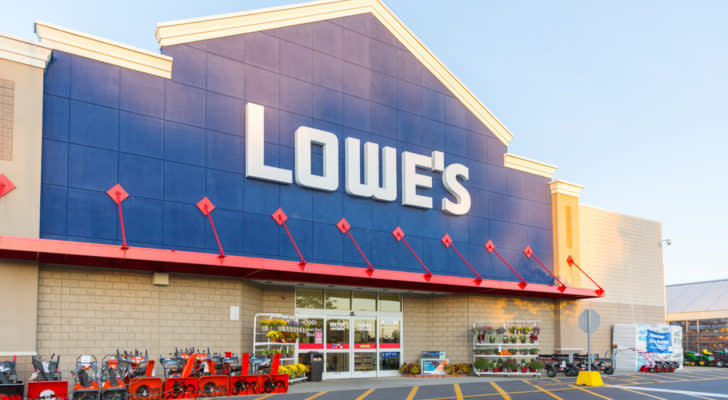
Source: Helen89 / Shutterstock.com
Fundamentally, Lowe’s (NYSE:LOW) represents the “small ball” among dividend aristocrats. When you put LOW in your lineup, you’re not trying to launch one into the upper deck. Rather, its job is to put the ball safely into play, moving the runner from first to second. Subsequently, Lowe’s primary purpose in life (as it pertains to your portfolio) is to get on base.
As a retailer of various home improvement and renovation products, Lowe’s doesn’t exactly offer the most look-at-me valuation metrics. Instead, its core attributes focus on consistent annual profitability, helped by its above-sector-average trailing-year net margin of 6.48%. That said, it does feature an impressive three-year revenue growth rate of 18.4%, above 80.44% of rivals.
For passive income, Lowe’s carries a forward yield of 2.22%. Notably, it commands 50 years of consecutive dividend increases. Also, its payout ratio sits at 30.59%, providing confidence for yield sustainability. Analysts rate LOW a moderate buy with a $248.68 target, implying almost 26% upside potential.
Colgate-Palmolive (CL)
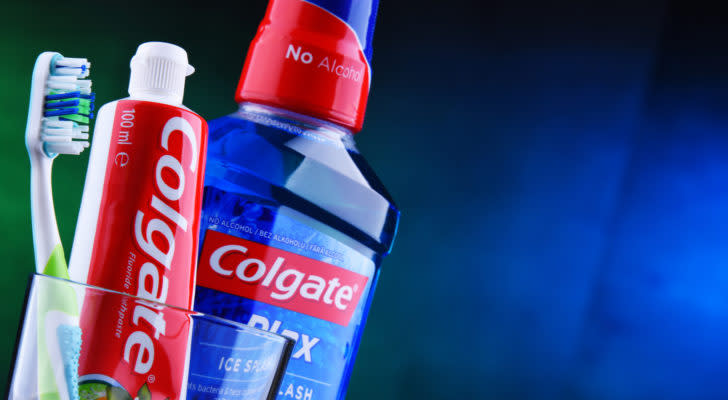
Source: monticello / Shutterstock.com
In some ways, Colgate-Palmolive (NYSE:CL) is a utility player for your portfolio. By definition, utility players don’t have the offensive prowess of regular, everyday starters. However, they may offer pivotal importance during a long season thanks to their ability to play multiple defensive roles. And that’s basically what you get with Colgate-Palmolive.
Known for its dental care products, Colgate isn’t exactly lighting up the charts. Since the January opener, it’s actually down 9%. And over the past five years, it only moved up about 12%, which isn’t particularly exciting by itself. However, CL benefits from consistent profitability, something you’d expect from one of the dividend aristocrats. Also, it features a superior return on asset (ROA) of 9.34%, above nearly 84% of its peers.
In terms of passive income, Colgate features a forward yield of 2.66%. Also, it commands 61 years of consecutive dividend increases, thus generating significant trust. Analysts peg CL as a moderate buy with an $80.77 target, implying just over 12% growth.
PepsiCo (PEP)

Source: FotograFFF / Shutterstock
A solid leadoff hitter, PepsiCo (NASDAQ:PEP) appeals to patient investors because it’s likely just going through a temporary rough patch. Since the start of the year, PEP lost almost 11% of its equity value. That alone sounds unappealing. However, it’s important to consider the context. Last week, PepsiCo beat bottom-line estimates, producing earnings per share of $2.25 versus the $2.17 expected.
Investors have come to expect this kind of consistency from the soft drink and snacks giant. More upside performance financially could be on the way. As pressures against the consumer economy increase, PepsiCo may benefit from the trade-down effect. Basically, people will trade down from eating out at food and beverage establishments and head to the grocery store.
For passive income, the company carries a forward yield of 3.16%. Also, it enjoys 52 years of annual dividend increases, making PEP one of the top dividend aristocrats. Lastly, analysts rate PEP a moderate buy with a $189.13 target, implying 18% upside.
Chevron (CVX)

Source: Sundry Photography / Shutterstock.com
To further extend the baseball analogy, oil and gas giant Chevron (NYSE:CVX) effectively plays the two-hole in the lineup. Its main job is to move the leadoff runner into scoring position while of course avoiding grounding into double plays. Some of the best two-hole batters feature characteristics of a leadoff and power hitter, like the San Diego Padres’ Manny Machado.
Fundamentally, Chevron is essentially batting on a hitter’s count. Early last month, Saudi Arabia and Russia – both powerhouse oil producers – agreed to voluntarily extend their production cuts through the end of this year. Plus, with geopolitical tensions and flashpoints raging, you’d figure that hydrocarbon supply will run low. Therefore, CVX is one of the dividend aristocrats cynically positioned to benefit.
Speaking of dividends, Chevron offers a forward yield of 3.6%. While that’s a bit lower than the energy sector average of 4.24%, the company also commands 37 years of consecutive dividend increases. Also, analysts rate CVX a moderate buy with a $190.62 target, implying nearly 14% growth.
AbbVie (ABBV)
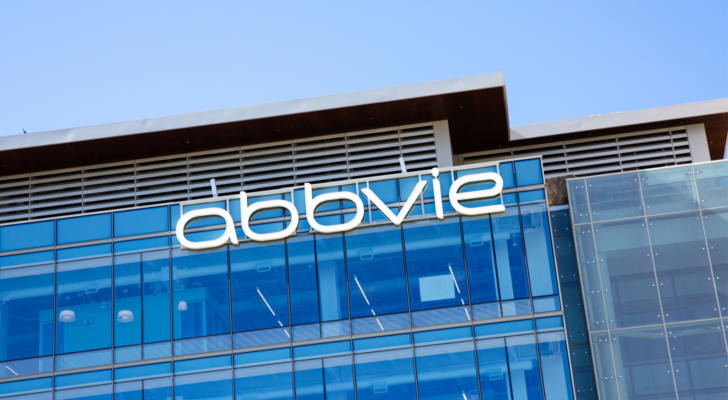
Source: Valeriya Zankovych / Shutterstock.com
A pharmaceutical giant, AbbVie (NYSE:ABBV) might fit into the three-hole scheme regarding dividend aristocrats for your portfolio. Fundamentally, the company offers exceptional relevance for its myriad therapeutics, including Humira for a range of autoimmune diseases. However, with its buyout of Allergan, AbbVie stands to benefit handsomely from certain social dynamics.
With the advent and wide proliferation of video-sharing platforms like YouTube and TikTok, young generations are obsessed with their youth and the physical vitality that goes with it. I’m betting that Generations Y, Z, and whatever comes after will have an extraordinarily difficult time letting their youthfulness go. So, I anticipate a massive spike in long-term demand for ABBV stock.
While you’re waiting, AbbVie offers a forward yield of 3.97%, well above the healthcare average yield of 1.58%. Also, it commands 51 years of consecutive dividend increases. Its payout ratio of 53.2% — while somewhat elevated – isn’t bad at all in the grand scheme of things. Analysts rate ABBV a consensus moderate buy with a $169.67 price target, projecting nearly 14% upside.
Essex Property Trust (ESS)
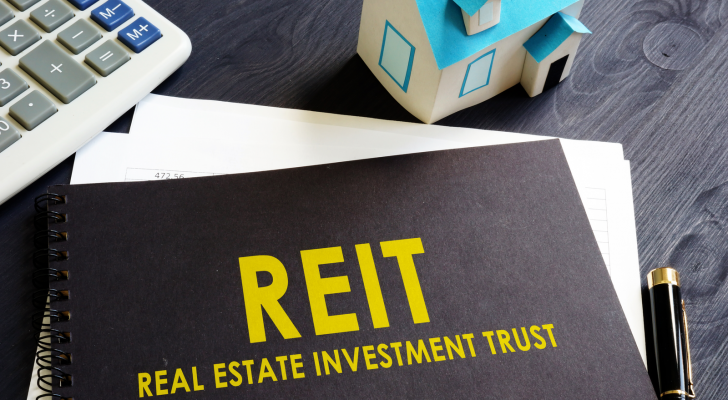
Source: Vitalii Vodolazskyi / Shutterstock
For the last two ideas on this list of dividend aristocrats, I’m going to label them as pinch hitters. They could do something special or they could fall flat; it’s difficult to say. First up, we have Essex Property Trust (NYSE:ESS). Structured as a real estate investment trust (REIT), Essex invests in apartments, primarily on the West Coast of the U.S.
On paper, that’s a great (cynical) business. Millions of people need places to live and they’ve been priced out of residential real estate. However, there’s also a certain point where the consumer economy just can’t take any more. That might be the reason why the implied volatility (IV) curve for ESS stock options indicates more traders hedging for downside risk than for upside reward.
Still, if you don’t believe in an upcoming correction in the broader residential living space ecosystem, Essex offers a forward yield of 4.22%. However, the payout ratio stands at 152% so you want to be careful. Even analysts peg ESS a hold though their $247.71 target implies 13% growth.
Amcor (AMCR)
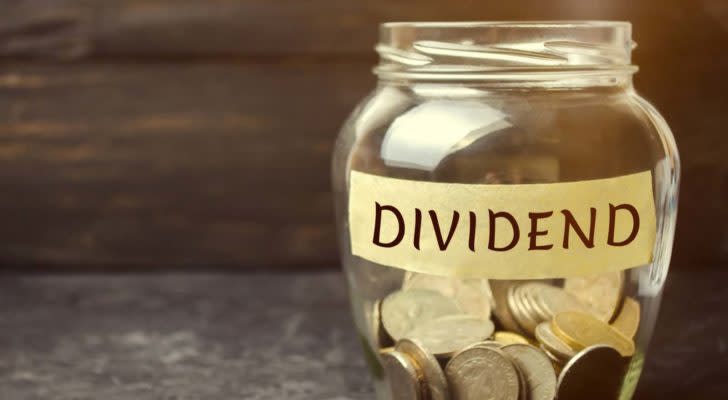
Source: Shutterstock
Another pinch hitter or batter near the bottom of the order, Amcor (NYSE:AMCR) represents a long shot among dividend aristocrats. Narrative-wise, I appreciate the speculative proposition. As a global packaging company, Amcor enjoys broad relevance. It provides flexible packaging, rigid containers, and specialty cartons for food, beverage, pharmaceutical, medical-device, home/personal care, and other product industries.
Unfortunately, it hasn’t translated to wins in the charts. Since the start of the year, AMCR lost almost 26% of its equity value. However, for patient investors, Amcor’s time to shine could soon materialize. Essentially, the company may benefit downwind from the trade-down effect. As people stop eating out at restaurants and drinking coffee at pricey cafes, demand for packaging should increase.
We’re already seeing the rise in private-label products, which boosts Amcor’s revenue. The same thing could happen in the U.S. market. While you’re waiting for the narrative to pan out, AMCR features a forward yield of 5.54%. To be sure, analysts find AMCR risky, pegging it a hold. However, if you want to speculate on a forward-looking catalyst, Amcor is enticing.
On the date of publication, Josh Enomoto did not have (either directly or indirectly) any positions in the securities mentioned in this article. The opinions expressed in this article are those of the writer, subject to the InvestorPlace.com Publishing Guidelines.
More From InvestorPlace
The #1 AI Investment Might Be This Company You’ve Never Heard Of
Musk’s “Project Omega” May Be Set to Mint New Millionaires. Here’s How to Get In.
The Rich Use This Income Secret (NOT Dividends) Far More Than Regular Investors
The post 7 Dividend Aristocrats to Batten Down the Hatches appeared first on InvestorPlace.
